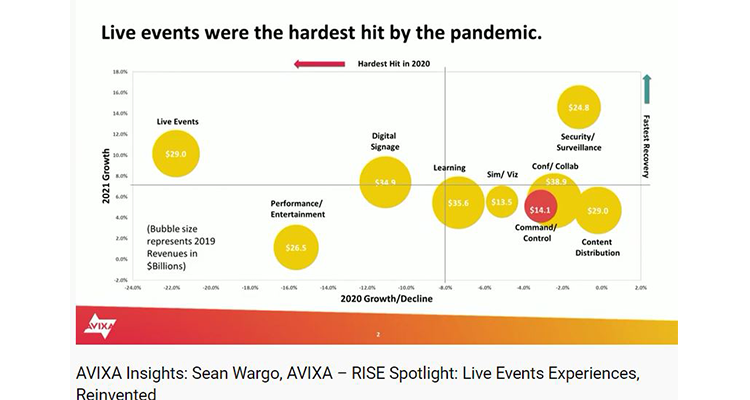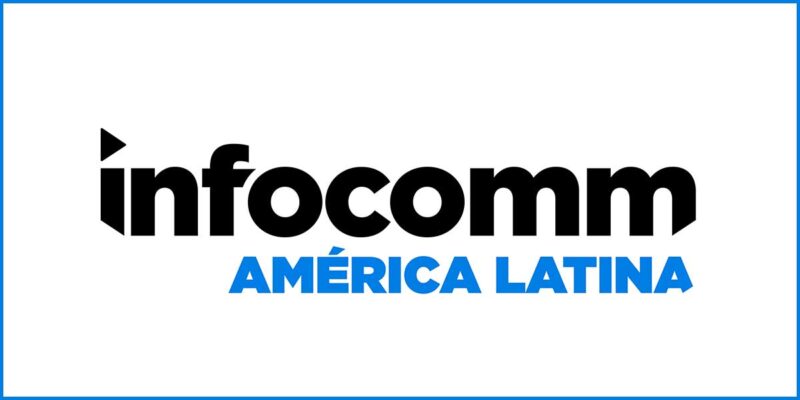RISE Spotlight: Live Events Experiences, Reinvented

Oh, how much we all miss live events. No matter how much you miss live events, you can’t possibly miss them as much as the people whose entire livelihood is based on live events. The latest thought-leading RISE series by ISE, turned its “Spotlight” on live event experiences and the “reinvention” that will mark their return.
Sean Wargo, senior director, market intelligence at AVIXA, kicked off a multipart look at the sector with a dose of reality, “… live events out of all solution areas was among the hardest hit in terms of revenues for the ProAV sector. We’re looking at about a 25% decline. And — actually — in final analysis, we think that things may be much worse.”
Yes, it most likely is much worse but it’s important to acknowledge that, out of the sectors in our industry, live events have been hit worse. The sector has responded with impressive solidarity, invoking public pressure to inspire government action — as well as the ingenuity to adapt to virtual and hybrid events.
How long before we see this exciting segment return to pre-pandemic levels? Wargo said “… although it’s one of the fastest growing areas in 2021 … 2020 was down to $23 billion. It really takes a while for us to get out of that low period … it’s really not until that ‘24 period, 2024 period where we really see revenues, surpassing the peak that was 2019.”
And the rate of recovery was really different by region. APAC and even Europe are starting to see a return. Notes the AVIXA market intelligence director, “We expect therefore for ‘21 to be a bit better for EMEA, APAC while the Americas still kind of comes back online. So, 10%, 11%, possibly even 15%, 16% growth there as revenue returns. Once again, the story being about a long tale of recovery.”
Recovery is also linked to the types of technologies offered by providers, and those are largely back-end systems. Wargo concluded, “… a large percentage of investment is in IT infrastructure to support hybridization of events.”
Digitisation of Live Events
Taking as its theme “The digitisation of live events,” the ISE Reporter Roundtable during this RISE Spotlight on live events addressed some of the challenges of the past year, the surprises it brought and what the future of live events could look like.
With guest moderator Stew Hume, the Editor of TPi, the expert panel discussed how — the last year —the quality of digital events has accelerated: We have moved on from the days of artists performing live on their mobile phones; full-scale production of digital music events is here.
The lockdown had an immediate impact on work on panelist Rik Salmon at his company (ATC Management Artist Management and Music Consultancy) company based in London and Los Angeles, with offices in New York, Copenhagen). He then took a risk founding an online platform selling tickets for livestreamed events. It paid off — his new company, Driift, has sold over 400,000 tickets since launch.
Salmon said, “…this is an exciting new model for live music. New opportunity, new revenue stream — new everything. It’s a small ray of light in a pretty dark time for our industry.”
For Creative Director Emma Bull, the one-off livestreamed productions felt overwhelming at first but also provided a beacon of hope that she, along with her “touring family,” could finally get back to work. In November, Niall Horan’s live performance was streamed — at an empty Royal Albert Hall.
Bull noted, “… putting on a one-off show in an iconic venue means you don’t have to worry about the constraints of how the aesthetic translates between venues. From a design point of view you can work very much with the architecture of the building … it was unique.”
For Robin Collings, the challenge was reinventing a virtual festival experience that still felt authentic: His team connected with VR gaming platform Sansar to develop a new experimental project.
“We started exploring the Sansar platform; it was amazing that you can still dance side-by-side with other people,” said Robin. “It allowed us to emulate elements of live events: you can still make new friends, explore live music performances, and experience the charisma of stage shows via the headset. A challenge was not to appear gimmicky, so we pushed for green-screen functionality within the computer world which allows the audience a more authentic connection with the performer.”
On the Sofa with Wob Roberts
In discussing the future of the live events industry and crew workforce, Roberts shared this thought (as well as others you can hear in the video), “I think it’s going to be a question of tripping over your own feet. Because when we come back, the desire to go back will be massive, and there will be a lot of people that will want to go out the moment that the gates are open. There are a lot of tours wanting to do stuff. There’ll be a lot of people going right, “Okay, let’s do this.” Some of the rescheduled tours that I’ve seen just the routings are incredibly tight, even by the old standards. And what none of that has taken into account is match fitness. A lot of people will have done nothing for 18 months. And then all of a sudden, you’re going to expect, you know, riggers to be going into the sky and pulling two-ton motors on a daily basis. And there are people that are just not going to be physically able to do this, because what we did was very strenuous.”
At the Watercooler: The Road to Recovery
Thompson highlighted it’s not always possible to pivot a physical event to online, with some clients instead feeling the need to scale back. For those other clients who embrace hybrid, the challenge for AV companies has been selling the higher production values that a professionally managed event brings
“I think part of the competitive challenge for us is being able to sell higher production values to our clients,” points out Thompson. “And I think the added value, the added benefit for an event. We worked on one with LTSMG, November, and it was really well attended. It was just a Zoom call, but we’ve tried to push the production values a little bit higher. We’ve had some virtual sets and there was a lot of stuff sent out by LTSMG to try and integrate with their audience on the day and afterwards. So, there was beer sent out, tastings and stuff.”
He added, “I think the big area we’re focused on is preproducing content for live events, like VT so you can playback stuff and make it look a bit snazzier, reduce the stress on the event on the day … And the post-production as well, of course, you know, editing and graphics, and so on.
“…public address, lighting and all the kind of stuff which you might expect on a live physical event– I don’t think that there’s going to be much space for those moving forward. So, we may be having a bit of a clear out of store soon. But yeah, cameras, obviously, we’ll be using those. Computing equipment, we’ve made big investment in computing equipment for virtual production and managed hybrid events. So, that’s the area that we’ve been pushing in. And I think that’s certainly the way it’s going to go.
“I mean, I was thinking about this earlier, I mean, my background of, you know, you have a green room with a couple of technicians in, they’re putting microphones on presenters, getting PowerPoint presentations, taking them through, you know, how they’re going to use the podium and all that kind of stuff. And an international conference is 15 hours a day, four days, with lots of different breakout rooms and stuff. That is kind of gone now. And that’s really my background. So, I kind of feel like I’m in over my head, you know, because this is a new area for me. I mean, a lot of the people I work with they’re just freshly graduated out of university. And these guys have hit the ground running with regards to things like vMix and Zoom and obviously, taking in lots of calls and doing a virtual production like that. So, I’m kind of learning as well,” continued Thompson.
“Well, I mean, one of the benefits of COVID is that I have an awful lot of time on my hands. So yeah, we’ve been learning a lot of things. I mean, there is no end to the learning possibilities. We’re working with Unreal Engine. So, we’re looking at some of the virtual production capabilities of that. Obviously, that’s revolutionize the movie industry is you’ll know with like Disney’s Mandalorian. I mean, everybody can see where this is going to go. So, it’s an absolute brain bomb that’s going off there is crazy. But yeah, anything like that.
“vMix, I’ve been learning a lot about vMix is that I don’t know if they’re using it for this particular one actually. But, you know, you can have people come in on a call and they’re using virtual cameras …They’re using virtual audio connections and bringing Zoom in. There’s so much stuff. But I mean, this is just scratching the surface. There’s a lot to learn. So, I’m still learning.”
Thompson concluded his observations, “ … what’s happening with companies like ours anyway is they’re either reducing their costs, their operating costs and the cost of the customer as well. And diversifying with their services. So, offering more or changing what you’re doing. It’s a tricky one. I mean, really hard. I mean, as I said, we haven’t actually done that well. I mean, most of our clients are venues, and they’ve all been shut. So, you know, we’re trying to get on the bandwagon of getting these put new clients in. But, you know, the competition is rife. There’s a lot of bigger companies out there who are better funded than us. And, you know, it’s very difficult. Yeah, I don’t think there is any sort of magic bullet for it, no.
“…So, it is changing the competitive marketplace for sure. But, yeah, I mean, we’re still trying to figure out what we’re going to do to be honest.”
Wargo asked, “Is there anything that you can kind of divine about how your clients may be talking about that engagement and how it changes?”
“Well, I think that most of our clients were the content creators …” noted Thompson. “I mean, there wasn’t really any room for interaction unless it was an event, you know, where you had people in a room. So, I guess there’s a learning process there for content creators. I mean, that’s part of our job as well as the production company is to guide on the best way to create the content that’s going to get that kind of response from your audiences when they’re remote. Obviously, shorter content is a big thing and you can’t have an hour-long symposium anymore. It’s like 15 minutes or something. And so obviously, branding it and making it look sexy, you know, having like little bits in between, so you can break it up.
“Gamification is something we’re looking at. So, making it a bit more fun, and having some kind of incentive to stay for the whole event, and maybe some prizes and stuff like that. So, you know, all of this kind of thing I think is going to improve the way you get your content across your audience.”
At the Watercooler: Diversity
Denmark-based Malle Kaas, CEO, Women in Live Music invited Sana Romanos, live sound engineer and project/tour manager (the only Arab live sound engineer in Middle East) and Alanna Pepin-Danissen, freelance lighting and visual technician to join in the discussion.
While 7.8 million people work backstage in live events across Europe, WILM estimates there may be only 100,000 women in the industry instead of a million you’d expect. The job at WILM is to highlight women in the industry to encourage other women. The industry women now will pave the way for women in the future. And WILM thinks a lack of role models inhibits women from stepping up.
WILM presented a report of its activities including professional profiles for employers, events (40 pre-COVID events in eight European countries with more than 1,000 attendees) and publications.
WILM has commissioned a motherhood survey, which highlighted the issues facing female professionals contemplating parenthood. As Pepin-Danissen explained, some women had taken the decision not to have children because of their career, while others felt the need to hide their pregnancies out of fear it would mean they wouldn’t get any work.
“The survey identified possible solutions to open up the opportunity to have pregnant crew members on tour and babies on board,” said Pepin-Danissen. “Firstly, women should share their experiences and how they managed. Venues and employers could also do a lot — make space to bring children, hire chaperones to take care of children. All of this costs money so the next step is to bring the discussion up to unions and governments to find funds for this.”
Startup Nation
The shift to virtual and livestreamed events during the past 12 months creates opportunities for enterprising young companies. For the Startup Nation session of the RISE Spotlight on live events, moderator Már Másson Maack (editor of growth quarters at TNW), spoke with Yvan Boudillet (founder of The Lynk, a strategic consultancy connecting creative industries and startups) and Tom Wilson (partner at venture capital fund Seedcamp) who nominated the latest companies to keep on your radar.
Last year, Boudillet’s consultancy conducted extensive research with more than 280 professionals from the tech and entertainment industries. The survey set out to ascertain the most valuable feature of virtual events going forward — not only aspects that would attract an audience, but that would also enable experiences to be monetised. The top three results were:
- Immersive sound
- Social interaction between audience and performer
- Multi-angle camera control
We might want to return to pre-pandemic conditions, but, according to Boudillet, the “livestream experience is here to stay. Many companies are starting to crack the most important elements” and future events will have to incorporate digital aspects as the audience comes to expect this additional element to conventional live music events.
Highlighting some startups to watch, Tom Wilson covered six companies helping to shape the virtual events industry:
- Hopin is an online events platform where you can create engaging virtual events that connect people around the globe. According to Wilson, the company has had “a phenomenal growth story” over the past 12 months and is “only just scratching the surface of what’s possible.”
- PortalOne is a hybrid games company in Norway, delivering live game experiences with stunning visuals and next level interactivity. Wilson described it as “a company to watch … they’re building a platform to allow insertion of individuals into certain games” for the ultimate interactive experience.
- Wave produces live, interactive and immersive shows that are unlike any other virtual concert. It combines the best of live music, gaming and broadcast technology to transform the live music experience and is streamed globally. Wilson said Wave allows for an “equally and alternatively exciting and engaging experience” to real life events.
- Tandem is a virtual office for remote teams to rediscover the flow of working together in‑person, “leading the way in creating office-like layouts and environments” said Wilson. The tool helps “people experience the serendipitous connection they would achieve in an office” through its ability to see, talk to and collaborate with colleagues in one click.
- mmhmm is a new way to communicate via video with tools, designed for presentations. Tom explained that the company is “creating more innovative and interesting ways people can present with the ability to interact and manipulate live slides, making the format of presenting more native.”
- VirtualTrips is a travel specific livestreaming platform, it allows local guides to share the places they know best with the hope that it can bring people around the world closer together.
During the session, an audience poll was taken and Hopin (also the platform used to host RISE Spotlight events) as voted the top startup of this group to watch.
Live Events at ISE 2021
With all the absorbing content in this RISE Spotlight, it’s easy to overlook one important point.
ISE is leading by example, leveraging a livestreamed event to promote its physical event in Barcelona.
With events producers increasingly looking to deliver an immersive experience that begins at the entrance to the venue, a new Live Events Zone at ISE 2021 will showcase lighting and lighting control, rigging and staging equipment, motion tracking, video mapping, holography and much more besides. It will be full of solutions for small temporary venues right up to major stadium concerts.
This online RISE Spotlight provided a broad range of insights that we all found valuable. But in no way does it discourage us from looking forward to the day we gather live in Barcelona.




